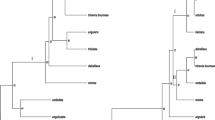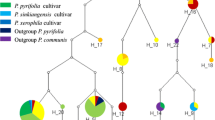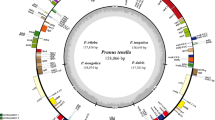Abstract
Chloroplast DNA (cp) and nuclear ribosomal DNA (rDNA) variation was investigated in 45 accessions of cultivated and wild Manihot species. Ten independent mutations, 8 point mutations and 2 length mutations were identified, using eight restriction enzymes and 12 heterologous cpDNA probes from mungbean. Restriction fragment length polymorphism analysis defined nine distinct chloroplast types, three of which were found among the cultivated accessions and six among the wild species. Cladistic analysis of the cpDNA data using parsimony yielded a hypothetical phylogeny of lineages among the cpDNAs of cassava and its wild relatives that is congruent with morphological evolutionary differentiation in the genus. The results of our survey of cpDNA, together with rDNA restriction site change at the intergenic spacer region and rDNA repeat unit length variation (using rDNA cloned fragments from taro as probe), suggest that cassava might have arisen from the domestication of wild tuberous accessions of some Manihot species, followed by intensive selection. M. esculenta subspp flabellifolia is probably a wild progenitor. Introgressive hybridization with wild forms and pressures to adapt to the widely varying climates and topography in which cassava is found might have enhanced the crop's present day variability.
Similar content being viewed by others
References
Abraham A (1957) Breeding of tuber crops in India. Indian J Genet Plant Breed 17:212–217
Allem AC (1984) A taxonomic revision of Manihot section Quniquelobae. PhD thesis, University of Reading, Reading, UK
Allem AC, Hahn SK (1988) Cassava. In: Hahn (ed) Workshop Genet Resources Selected Crops Africa. IITA, Ibadan, Nigeria, pp 88–110
Appels R, Dvorak J (1982) The wheat ribosomal DNA spacer region: its structure and variation in populations and among species. Theor Appl Genet 63:337–348
Appels R, Honeycutt RL (1986) rDNA: evolution over a billion years. In: Dutta SK (ed) DNA systematics. CRC press, Boca Raton, Fla, pp 81–135
Bai KV (1985) Recent advances in Cassava genetics and cytogenetics. In: Hershey CH (ed) Cassava breeding: A multidisciplinary review. Proc Workshop the Philippines 4–7 March 1985. Cali Colombia: CIAT, pp 35–39
Bai KV (1992) Cytogenetics of Manihot species and interspecific hybrids. In: Proc 1st Int Sci Meeting Cassava Biotechnol Network (CBN). Cartagena de Indias, Colombia (in press)
Bolhuis GG (1953) A survey of some attempts to breed Cassava with a high content of proteins in the roots. Euphytica 2:107–112
Bryne D (1984) Breeding Cassava. In: Jannick J (ed) Plant breeding reviews, vol 2. Avi, Westpoint, USA, pp 73–134
Dellaporta SL, Wood J, Hicks JR (1983) A plant DNA minipreparation: version II. Plant Mol Biol Rep 1:19
Doyle JJ, Beachy RN (1985 b) Ribosomal gene variation in soybean (Glycine) and its relatives. Theor Appl Genet 70:369–376
Dvorak J, Appels R (1982) Chromosomes and nucleotide sequences differential in genomes of polyploid Triticum species. Theor Appl Genet 63:349–360
Erickson LR, Strauss WA, Bevensdorf WD (1983) Restriction patterns reveal origins of chloroplast genomes in Brassica amphidiploids. Theor Appl Genet 65:201–206
FAO (1991) Food outlook. FAO, Rome, Italy
Flavell R (1982) Sequence amplification, deletion and rearrangement: Major Sources of variation during species divergence. In Genome evolution. Edited by G. A. Dover and R. Flavell. Academic press, New York, pp 301–323
Hahn SK, Bai KV, Asiedu RA (1990) Tetraploids, triploids, and 2n pollen from diploid interspecies crosses with Cassava. Theor Appl Genet 79:433–439
Harris SA, Ingram R (1990) Chloroplast DNA and biosystematics. The effect of intraspecific diversity and plastid composition. Taxon 40:393–412
Harlan J (1970) Evolution of cultivated plants. In: Frankel OH, Bennet E (ed) Genetic resources of plants — their exploration and conservation. IBP Handbook No. 11. Blackwell Sci Publ, Oxford Edinburgh, pp 19–32
Hosaka K, Hanneman RE (1988) The origin of the culivated tetraploid potato based on chloroplast DNA. Thoer Appl Genet 76:172–176
IITA (International Institute of Tropical Agriculture) (1988) Annual report 1988, IITA, Ibadan, Nigeria
IITA (International Institute of Tropical Agriculture) (1990) Cassava in tropical Africa. A reference manual. IITA, Ibadan, Nigeria
Jackson PJ, Lark KG (1982) Ribosomal RNA synthesis in soybean suspension cultures growing in different media. Plant Physiol 69:234–239
Jennings DL (1957) Further studies in breeding Cassava for virus resistance. East Afr Agric J 22:213–229
Jennings DL (1963) Variation in pollen and ovule fertility in varieties of Cassava and the effect of interspecific crossing on fertility. Euphytica 12:69–76
Jennings DL (1976) Cassava Manihot esculenta (Euphorbiaceae). In: Harlan J (ed) Cultivated crops. Longman, London, pp 81–84
Jones WO (1959) Manioc in Africa. Stanford University Press, Stanford Calif.
Magoon ML, Jos JS, Appan SG (1969 a) Cytomorphology of the interspecific hybrid between Cassava and Cerea rubber. Chromosome Inf Serv 7:8–9
Magoon ML, Krishnan R, Bai KV (1969 b) Morphology of the pachytene chromosomes and meiosis in Manihot esculenta crantz. Cytologia 34:612–626
Matthews P (1990) The origin, dispersal and domestication of Taro. PhD thesis, Australian National University, Canberra, Australia
Nassar NMA (1978) Conservation of the genetic resources of Cassava (Manihot esculenta Crantz): determination of wild species location with emphasis on probable origin. Econ Bot 32:311–320
Nassar NMA (1979) Interspecific crosses between cassava and four wild Manihot species from central Brazil. Egypt J Genet Cytol 8:175–179
Nichols RW (1947) Breeding Cassava for virus resistance. East Afr Agric For J 12:184–194
Palmer JD (1987) Chloroplast DNA evolution and biosystematic uses of chloroplast DNA variation. Am Nat 130:S6-S29
Palmer JD, Zamir D (1982) Chloroplast DNA evolution and phylogenetic relationships in Lycopersicon. Proc Natl Acad Sci USA 79:5006–5010
Palmer JD, Jansen RK, Michaels HJ, Chase MW, Manhart JR (1988) Chloroplast DNA variation and plant phylogeny. Ann Mo Bot Gard 75:721–726
Rogers DJ (1963) Studies on Manihot esculenta Crantz, Cassava and related species. Bull Torrey Bot Club 9:43–54
Rogers DJ, Appan SG (1973) Manihot and Manihoides (Euphorbiacea) flora. Neotropical Monograph No. 13. Hafner Press, New York
Rogers SO, Bendich AJ (1987) Ribosomal RNA genes in plants: variability in copy number and in the Intergenic Spacer Plant Mol Biol 9:509–520
Saghai-Maroof MA, Soliman KM, Jorgesen RA, Allard RW (1984) Ribosomal DNA spacer-length polymorphism in barley: Mendelian inheritance, chromosomal location, and population dynamics. Proc Natl Acad Sci USA 81:8014–8018
Sano Y, Sano R (1990) Variation of the intergenic spacer region of ribosomal DNA in cultivated and wild rice species. Genome 33:209–218
Soltis DE, Soltis PS (1989) Allotetraploid speciaton in Tragopogon: insights from chloroplast DNA. Am J Bot 76:1119–1124
Southern EM (1975) Detection of specific sequences among DNA fragments separated by gel electrophoresis. J Mol Biol 98:503–517
Swofford D (1990) PAUP: Parsimony analysis using phylogeny: version 3.0. Illinois history survey, Champaign, Ill.
Systma KJ, Schaal BA (1985) Phylogenetics of the Lisianthus skinneri (Gentianaceae) species complex in panama using DNA restriction fragment analysis. Evolution 39:594–608
Terauchi R, Chikaleke V, Thottapilly G, Hahn SK (1992) Origin and phylogeny of guinea yams as revealed by RFLP analysis of chloroplast DNA and nuclear ribosomal DNA. Theor Appl Genet 83:743–751
Umanah EE, Hartmann RW (1973) Chromosome numbers and karyotypes of some Manihot species. J Am Soc Hortic Sci 98:272–274
Yakura K, Kato A, Tanifuji S (1984) Length heterogeneity in the large spacer of Vicia faba rDNA is due to a differing number of 325-bp repetitive sequence elements. Mol Gen Genet 193:400–405
Author information
Authors and Affiliations
Additional information
Communicated by D. R. Pring
Rights and permissions
About this article
Cite this article
Fregene, M.A., Vargas, J., Ikea, J. et al. Variability of chloroplast DNA and nuclear ribosomal DNA in cassava (Manihot esculenta Crantz) and its wild relatives. Theoret. Appl. Genetics 89, 719–727 (1994). https://doi.org/10.1007/BF00223711
Received:
Accepted:
Issue Date:
DOI: https://doi.org/10.1007/BF00223711




